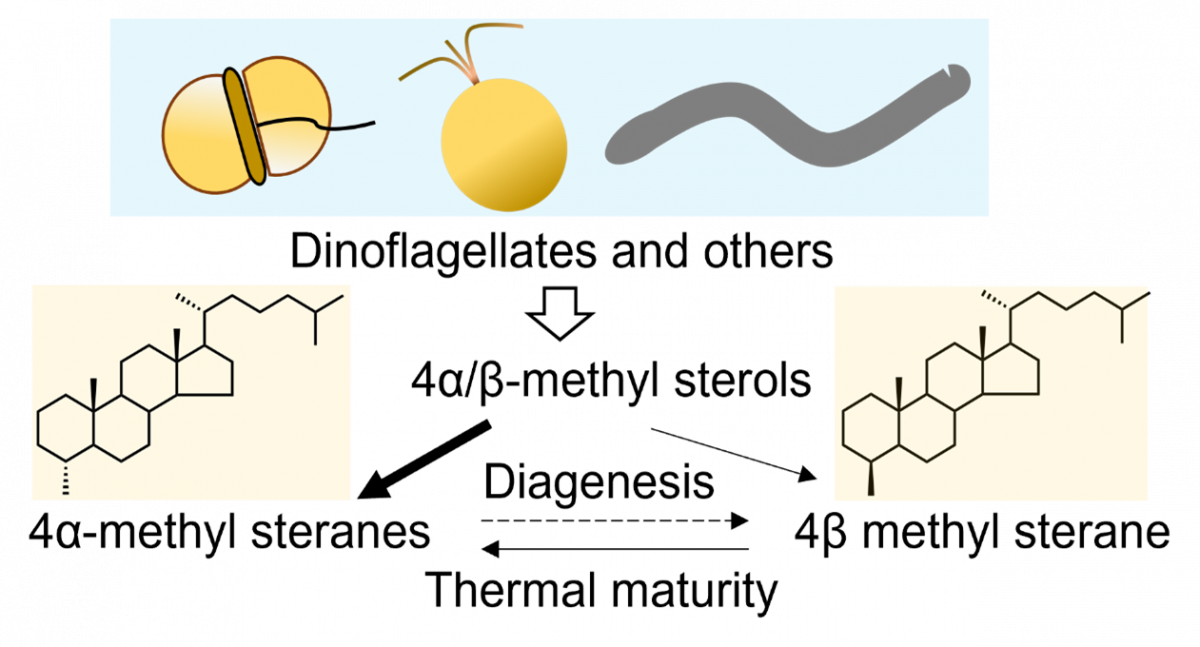Crude oil is the blood of the national industry. Biogeology is an important means to predict the presence of underground oil and gas reservoirs. The 4-methyl steranes serve as molecular fossils and are used for studying both eukaryotic evolution and geological history. The 4α-methyl sterenes are assumed to be formed diagenetically from 4α-methyl sterols produced by ancient organisms, such as dinoflagellates. However, this route has not yet been experimentally validated. In contrast, the origin of 4β-sterenes is still under debate given that their precursors, the 4β-methyl sterols, have rarely been detected in any organism. 4β-methyl steranes are attributed entirely to diagenetic generation from 4α-methyl steroids. Thermal breakdown occurs with increasing temperature and pressure during deeper burial of sediments where the abundance of less stable compounds (e.g., 4β-methyl steranes) is converted into their stable isomerization products (4α-methyl steranes). The 4α/4β-methyl sterane ratio can thus serve as an indicator of thermal maturity, which indicates the extent of the conversion of sedimentary organic material into gas, petroleum, and other products. Therefore, the 4α/4β-methyl sterane ratio has been used to interpret geological history and help distinguish actual oil and gas source rocks from merely potential source rocks.

Till now, the biosynthetic pathway for 4-methyl sterols has not been identified in any organisms that could be connected with fossils. Now, a research team led by Prof. LU Yandu from Marine Single-Cell BioEngineering Group (SCBE) of MRU collaborated with scientists from Massachusetts Institute of Technology and CSIRO Oceans and Atmosphere report a previously unknown C4-methyl sterol biosynthetic pathway involving a sterol methyltransferase. They show that both C4α- and C4β-methyl sterols are end products of the sterol biosynthetic pathway in an endosymbiont of reef corals, Breviolum minutum, while this mechanism exists not only in dinoflagellates but also in eukaryotes from alveolates, haptophytes, and aschelminthes.
“These organisms comprise a major proportion of the phytoplankton community that are globally distributed and exert large-scale impacts on ocean biogeochemistry.” team leader ZHOU Wenxu explained.
“The discovery provides a previously untapped route for the generation of C4-methyl steranes and overturns the paradigm that all 4β-methyl steranes are diagenetically generated from the 4α isomers. This may facilitate the interpretation of geological history and the discovery of crude oil and gas” said LU Yandu, group leader of SCBE and the senior author of the study.
Their findings were published on May 12 in Journal of the American Chemical Society https://pubs.acs.org/doi/10.1021/jacs.2c01401.
This work was supported in part by grants from the National Key R&D Program of China, the National Natural Science Foundation of China, the Key R&D Program of Hainan Province, and the Project of the State Key Laboratory of Marine Resource Utilization in South China Sea.
Call for Postdoctoral and Doctoral Programs for International Students
(No time limits)
Hainan Province locates on the southernmost tip of China and is the only Free Trade Island of China. Hainan University (HNU) is a comprehensive key university jointly administered by the State Ministry of Education and the People’s Government of Hainan Province. It is a leading university for science research and teaching of Hainan Province and was listed as one of China’s “211 Project” universities, one of the 14 universities in the “Midwest Universities Comprehensive Strength Promotion Project”, and a national-level key sponsored university in the “One Province, One School” project in the Midwest of China. In 2017, HNU was selected as the national “Double First-Class” Initiative to develop world-class disciplines. As an integrated institute of Hainan University, HNU has become one of the research and education centers in China.
Unicellular planktons, with an estimate of almost one million species, are of great ecological importance, as they contribute almost half of the global organic carbon fixation. They provide a variety of natural products to support ecosystems (e.g., coral reef ecosystem) by photosynthesis with efficiencies approximately three times greater than those achieved by land plants. Domesticated microalgae hold great promise for the sustainable provision of various bioresources for human domestic and industrial consumption.
The main interest of Single-cell BioEngineering Group (SCBE) is the evolution, function, and editing of single-cell microalgal genomes and design of synthetic biology using microalgae as chassis, including (1) Characterization and engineering crucial biological process and value-added chemical in microalgae (Zhou et al., 2022 JACS; Lu et al., 2021 Nat Comm); (2) Development and application of synthetic biology in cell factory design for medical, industrial, and agriculture ends (Lu et al., 2021 Cri Rev Biotech); (3) The interaction mechanism between microalgae and other microbes and strategy development for heavy-metal remediation approach using these consortia (Ahamad et al., J Harz Mater 2019, 2018).
We are now calling for Postdoctoral and Doctoral Programs for International Students
For more details: http://www.scbioengineering.com/recruit
